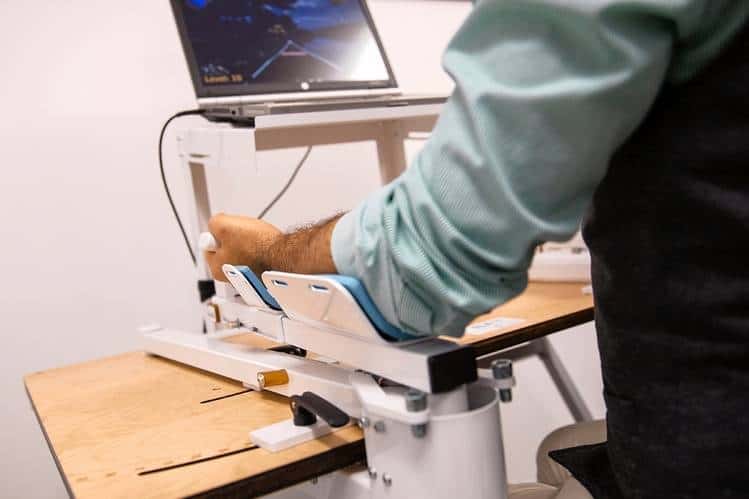On a Friday afternoon at Rusk Rehabilitation Brooklyn at Sunset Park Family Health Center, 96-year-old Mable Henry determinedly steps up and down a set of stairs, working to relearn balance and coordination. The Rusk Rehabilitation center, located at 150 55th Street in Brooklyn, is part of NYU Langone Health, and home to a clinic that’s exploring new treatment options through the use of video games.
The rehab room is filled with familiar equipment like treadmills and weights, but also houses joysticks and computer monitors – the hope being that patients can begin to heal through games that are fun and interactive and might appeal to a younger, more tech-oriented audience. The “gamification” of rehab may likely be the new frontier in recovery, as NYU Langone has noticed strokes are steadily affecting younger and younger people. Dr. Aaron Lord, chief of neurology at NYU Langone Hospital–Brooklyn, says, “Multiple studies in the U.S. and in Europe have shown alarming increases in ischemic stroke in young adults aged 20 to 45 over the last two decades.” However, according to Dr. Lord, the cause is unclear. “A small part of it is likely due to greater public awareness of stroke symptoms and improvements in our ability to diagnose stroke using MRI. But most of the increase is likely due to poorer health we see in many young adults, including increasing rates of obesity, diabetes, and high cholesterol as well as the increased use of illicit drugs nationwide,” reports Dr. Lord. Whatever the case might be, on this particular spring afternoon, Henry isn’t using any of the new technology. She has her eyes set on a set of stairs she determinedly keeps stepping up and down on, regaining her strength.
Only five days ago Henry experienced a left-sided stroke. She is currently under the watchful eye of a young and unfailingly encouraging therapist. At another table, a tiny Russian woman sits with a tattooed therapist, working on a puzzle, her grandson translating. Henry’s daughter Gwendolyn sits nearby. Although calm and composed, Gwendolyn never takes her eyes off her mother. As Branden Dennis, senior physical therapist and program specialist of neurology at NYU Langone Hospital–Brooklyn, says, “The goal is for Mable is to get back to where she was before, using her cane out in the community.” But it’s obvious Henry has the situation under control. Although moving slowly, she walks steadily and smiles often.
Henry, who was born in a small town in North Carolina, has lived in Crown Heights since 1976. She first moved to Harlem in 1945. Her early memories of the neighborhood were seeing performers at the Apollo. Henry enjoyed going to the movies and loved the buzz of Manhattan after growing up in the South. She was married for over 50 years, taught fourth grade before becoming a mother, and worked in the credit department at B. Altman for most of her adult life. Henry is most proud of the years she spent raising her daughter, Gwendolyn, saying, “She never gave me any trouble.” Behind her mother, Gwendolyn winks. The two women have a Mother’s Day tradition of traveling together with other family, and have visited Europe multiple times together. Henry’s therapist, Maxwell Cutty, gently pushes Mable, one hand ready to prevent a fall, testing her reflexes. When Mable is finished, Cutty guides her towards her wheelchair only to discover someone else has co-opted the chair. “We’ll walk,” Cutty says. Henry looks nonplussed.
Back in her room, speech-language pathologist Jessica Alves meets Henry, announcing, “I’m back for you, Ms. Mable!” Although Henry admits to being tired out, Gwendolyn urges her mother, “Just get it over with! You can rest later.” Yesterday Henry attended a communication group where she met with other patients and speech therapists to work together to practice word retrieval, and she’ll stay at Rusk for another few days before she’s able to return to her home.
Jeffrey S. Fine, MD, chief of physical medicine and rehabilitation service at NYU Langone Hospital–Brooklyn, says, “Over 50 percent of our admissions each year is stroke. We treat 300 to 400 patients per year and the whole team becomes aware how to manage. We have a lot of sophisticated equipment in our gym, emphasizing the gamification of therapy. Key to anyone’s recovery is repetition. The question is how do we drive the brain to change in the setting of a new deficit.” As seen with Henry stepping up and down a set of stairs, the focus of rehabilitation for stroke victims is based in consistency and regaining skills that have been lost; the retrieval of information that has been erased by the stroke. For Henry, these skills are balance and speech, and for some, using a video game format might allow a quicker recovery.
When asked about her secret to longevity, Henry only shrugs but Gwendolyn pipes in, “She never smoke or drank.” Henry attends church at First Baptist and has been attending services her whole life. When she goes home, Henry is looking forward to returning to her garden in North Carolina where she plants flowers and tomato plants.
Gwendolyn assures her mother they’ll get down in time for Henry to plant her seeds.










One Comment
The story about Mable Henry
reflects a profile of a determined proud Christian woman who fully embraces
life. I am fortunate to have met Mrs H since I am a friend of her daughter, Gwendolyn.
Mrs H is truly a gracious lady and I wish her the very best.
Great article. Dorothy Wright